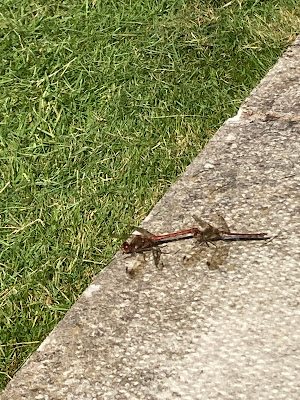Kathryn J Fegan contacted us with news of her garden transformation. Kathryn's achievements are really impressive and provide habitat for a wide range of wildlife. The results are a pleasure to see...
 |
| Bee and butterfly service station flower bed in full bloom |
I was both inspired and challenged by your articles over the summer to help wildlife in our gardens, and I just wanted to share the changes I’ve made in my back garden and how I’m enjoying the garden coming to life with bees, other insects, butterflies and a hedgehog.
 |
| The beginnings of the new flower bed |
 |
| Filling the bed with topsoil and compost |
My garden used to be a big square lawn with green shrubs around the sides. Very little changed through the seasons. Hardly any living things visited despite me putting out bird feeders and we had an ignored blue tit box.
 |
| Starting the new bed in the middle of May’s drought |
 |
| The finished flower bed |
Since March I have created a bee and butterfly service station flower bed to one side of the lawn by placing a layer of cardboard over the grass when it was brown in the hot weather, and covering this with a deep layer of topsoil and mushroom compost which I had delivered. The result has been spectacular and I have had fun identifying honey bees, carder bees, red tailed and buff tailed bumble bees and a cuckoo bumble bee.
I followed Charles Dowding’s no dig method from YouTube which preserves the soil structure and fungal connections beneath, is very much less hard work and in 2 months the cardboard is rotting and feeding the soil, and the plants are rooting into the rich soil below.
 |
| Perfect foraging for bees |
Then opposite to this I have dug a small shallow pond and already have 4 black diving beetles in it, and today a visit from a mating pair of common darter dragonflies.
 |
| Kathryn's small pond providing a home for aquatic insects |
 |
Common darter dragonflies
|
I have scarified the back half-moon of lawn and sown wildflower seed; it was a little late in the season so I expect to see better results next year but field grasshoppers now visit.
 |
| Grasshopper |
 |
| An area of lawn with longer grass and wildflowers |
I have dug up the back border and planted a mixed native hedge with hawthorn, hazel, blackthorn, field maple and dog rose. I planted whips so they’re about 3 feet tall now. I made 2 hedgehog holes in a fence and a gate, and now have hedgehog poo on the lawn. Gradually I am replacing green shrubs with native and bee-friendly plants.
I’ve been fascinated by the arriving insects and have been uploading them to iNaturalist for identification and recording. I’ve identified Green, Hawthorn and Sloe shield bugs in the garden - that started when one literally fell onto my knee as I sat in the garden with a coffee!
 |
| Red admiral on ivy flowers |
 |
Sloe shield bug
|
 |
| Green shield bug nymph |
All this change has been just one person in 7 months! I would like to encourage others to make the change for wildlife. I’ve found it fascinating to see how nature responds to just a little invitation from us, and my garden is now alive with insects and birds.














Brilliant- we've always gardened for wildlife but this year done the long/grass wildflower crescent of lawn - and cut the rest much less often. Now we're starting on the pond. Like you the change in visiting fauna has been amazing. But well done you!
ReplyDeleteKathryn did a wonderful job. We have also allowed some of our lawn to grow long and it has been surprising what has appeared. Good luck with your pond.
Delete